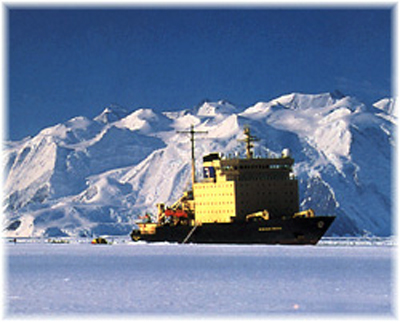The Northwest Passage: Yet Another Cruise Ship
 by Kevin Griffin
by Kevin Griffin
The fabled Northwest Passage took three years to cross when Raould Amundsen first traversed it from east to west in his Gjoa in 1903-06 and Henry Larsen of the RCMP made it the other way in his St Roch in 1940-42. A century later, however, large passenger ships such as the 43,524-ton residence ship The World and the 68,870-ton cruise ship Crystal Serenity are threatening to turn it into a tourist playground. Last week came news that yet another cruise ship, Regent Seven Seas Cruises’ 28,550-ton Seven Seas Navigator, would join the Crystal Serenity in making the passage in 2017. While Crystal sail from Seward to New York, Regent will be sailing from Seward to Montreal.
THIS WEEK’S STORY
The Fabled Northwest Passage
The legend of a shipping route across the top of North America for centuries led to the exploration and discovery of those waters, as well as death and misery as ships disappeared trying to find the fabled route from Europe to China. Since 1984, however, passengers have come along for the exploration as well.
Until 2015, complete transits of the Northwest Passage had been made by 162 different vessels.
The 12,288-ton 120-berth Russian icebreaker Kapitan Khlebnikov has made seventeen transits, the largest number of any vessel.
Hapag-Lloyd Cruises’ 8,378-ton 184-berth Hanseatic eleven, and their 6,752-ton 164-berth Bremen eight, two of them as Frontier Spirit, which at the time was jointly owned by Hapag-Lloyd and Salen-Lindblad, along with NYK Line, who only recently sold Crystal Cruises to Genting Hong Kong.
These 162 vessels, including government ships and yachts, came from thirty-one registries, with forty-seven from Canada, twenty-four each from Russia, the Bahamas and the United States, twenty-one from Britain and sixteen from France, many of the latter yachts.
The Crystal Serenity will set out from Seward, Alaska, on August 16, carrying about 900 passengers through icy Arctic waters to New York, where she is due to arrive on September 16, on her first 32-day Northwest Passage cruise. Built with forsight, her Ice Class 1C hull will allow her to offer excursions to various sites in Alaska, Pond Inlet and Cambridge Bay in Nunavut and several communities in Greenland.
Visitors will be able to go whale and polar bear watching, take helicopter flights to the interior and even visit the world’s most northerly golf course.
The Serenity will be escorted by the chartered 4,028-ton British Antarctic survey ship Ernest Shackleton, which is normally chartered commercially in the North Sea during the summer months.
Prior to the voyage Crystal Serenity will be outfitted with forward-looking sonar, ice detection radar, searchlights and thermal imaging equipment, as well as an ice navigation system that can display satellite ice imagery and ice forecasts. Her master and bridge team are attending ice navigation training at a simulator in St John’s, Newfoundland, and two experienced Canadian ice pilots will be on board to assist the bridge team with equipment not normally found on cruise ships.
The Ernest Shackleton will also carry an experienced ice pilot.
Crystal has more recently announced that it will return to the Northwest Passage in August 2017. Staring August 15 next year, she will sail a second 32-day expedition-style voyage traversing the Arctic once more from Seward, Alaska to New York via the legendary route, which will take her 500 miles north of the Arctic Circle.
In additon to these voyages, it seems certain that Crystal Yacht Cruises’ 20,000-ton 200-berth Crystal Endeavour will be assigned to NorthwestPassage cruises after she is completed in August of 2018. That same month, of course, Scenic’s new 16,500-ton 228-berth Scenic Eclipse is also due to be delivered.
Last week, however, it was Regent Seven Seas that announced it had decided to get in on the act, with the news of a 30-night Northwest Passage voyage to be offered on board its 490-berth Seven Seas Navigator.
Her itinerary will also start at Seward, but after travelling across the Arctic and calling on Greenland, she will sail the Gulf and River St Lawrence into Quebec and Montreal. The Navigator has in the past been offering annual voyages from Vancouver to Montreal, but via the Panama Canal.
The Seven Seas Navigator, like the Crystal Serenity, has her own secret. Like the Serenity, this vessel was also completed with ice strengthening. In the Navigator, however, this was not part of her present owner’s plans, but came about because the lower hull upon which she was constructed had originally been started for a Russian satellite tracking ship, but completed from deck three up in Italy as a cruise ship.
Meanwhile, although passenger ships sailing the Northwest Passage are now getting bigger, there is a history of three decades of passengers crossing the Canadian Arctic.
On August 20, 1984, the 2,398-ton 104-berth Lindblad Explorer left St John’s, Newfoundland, for a 43-day voyage that took her all the way to Yokohama, thus becoming the first ship to transit the Northwest Passage with paying passengers.
In 1985, the 3,153-ton 138-berth World Discoverer followed, becoming the first ship to transit the Northwest Passage in the opposite direction, when she completed a 32-day 6,295-mile voyage from Nome to Halifax for Society Expeditions.
But the passage is not without risk. As recently as 2014 ships have had to turn back without completing the whole whole passage. In 1986, the World Discoverer, trying to repeat her success of the previous year with a 31-day voyage between Greenland and the Aleutian Islands, had to turn back because of ice.
In 1991, ice prevented the 164-berth Frontier Spirit (now the Bremen) from completing an eastbound voyage.
Chartered by Salen Lindblad Cruising, she had to turn back at Point Barrow, 1,000 miles from Dutch Harbor, where she had begun. Even a Canadian Coast Guard icebreaker could not penetrate the ice, so she headed for Vancouver instead of St John’s and two East Coast cruises had to be cancelled.
But generally, the story of the Northwest Passage has been one of progress. In the summer of 2010, both of Hapag-Lloyd’s expedition ships, Bremen and Hanseatic, transited the full Northwest Passage, with one ship travelling in each direction. During their crossings, the two ships managed to rendezvous with each other for a barbecue near Cambridge Bay.
Other operators such as Canadian-based One Ocean Expeditions and Adventure Canada and US-based Lindblad Expeditions now offer transits of the Northwest Passage that run through the passage westbound then turn around for a return voyage back to the Atlantic again.
The year 2012 saw the 165-residence condominium ship The World make a full Northwest Passage voyage from Nome to Nuuk, Greenland, with about 200 passengers and a crew of 260. The World, which has Finnish Ice Class 1C, stopped at either end of the Passage, in Cambridge Bay and in Pond Inlet six days later.
Also during 2012, Paul Allen’s 9,932-ton mega yacht Octopus, also crossed the Canadian Arctic on her second crossing since 2010.
For the mega rich, the Dutch-based Damen group has just recently announced a new class of polar yacht that can break ice with the ship headed in either direction, forward or astern. It will come in three versions up to 328 feet, with the ability to provision for up to 40 days.
For the first time, three ships did the full Northwest Passage in 2013, one voyage each being made by Hapag-Lloyd Cruises’ Bremen and Hanseatic, travelling in opposite directions, and a first-time transit by Ponant’s 199-berth 10,944-ton Le Soléal.
In 2014, Silversea Expeditions completed its own first crossing, with the 6,072-ton 132-berth Silver Explorer arriving at Nome on September 1. For Silversea, this was its first-time crossing of the Northwest Passage.
And after being missing for 168 years, a 2014 voyage by One Ocean Expeditions managed to find one of Franklin’s two ships, HMS Erebus. This discovery alone will lead to more interest in Arctic tourism and the Northwest Passage that Franklin was in search of.
In 2015, in another first, Abercrombie & Kent chartered Ponant’s Le Boréal for a full transit from Kangerlussuaq to Anadyr. A&K thus became the fourth operator to offer the full passage between Atlantic and Pacific, joining Hapag-Lloyd Cruises, Silversea and Ponant themselves.
Le Soléal also made a voyage from Kangerlussuaq to Anadyr.
The Northwest Passage is also developing into an area of political intrigue. While Canada claims sovereignty to the islands of the Canadian Arctic, the United States has always maintained that the waters around them are international waters.
And while the Royal Canadian Navy is building six 340-foot Arctic Offshore Patrol ships in Halifax, the first of which, HMCS Harry de Wolf, is to be delivered in 2018, China has been making its own moves in the Canadian Arctic.

Quark Expeditions’ passengers will be the first travelers in the world to be able to combine four different voyages into an epic circumnavigation of the Arctic through the fabled routes of he Northwest and Northeast Passages, Greenland, and the Canadian High Arctic
In October 2014, China imported a full shipload of 23,000 tons of high-value nickel ore on the Canadian-owned icebreaking cargo ship Nunavik, cutting more than 40% off the distance via the Panama Canal.
The year before, another ship had carried 70,000 tons of low-value coal from Vancouver to Denmark.
This spring, however, China’s Maritime Safety Administration published a 365-page Chinese-language compendium of charts and detailed information on sea ice and weather called the “Arctic Navigation Guide” (Northwest Passage). China has so far led a middle course, however, backing neither the Canadian nor the American side in this debate, but talking instead about container ships and trade between China and Europe.
As we said last year, with the discovery of one of Franklin’s HMS Erebus and the presence of now no fewer than nine different cruise lines and expedition companies, as well as increasing cargo activity, watch for the Arctic to become an interesting space for cruising in future years.
(Kevin Griffin is managing director of specialist cruise agency The Cruise People Ltd in London, England. For further information concerning cruises mentioned in this article readers can visit his blog)
(See the last columns) – (Post a comment at the Forum)













